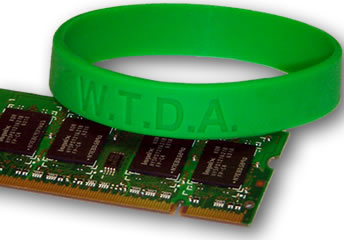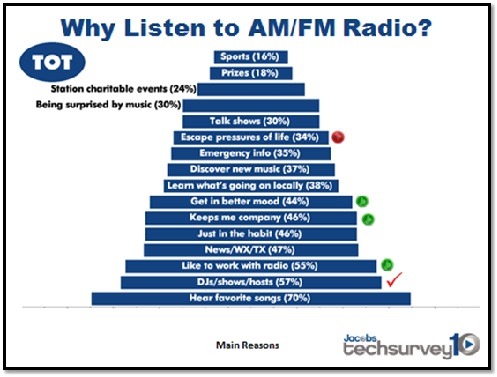Radio is beginning to figure it out. A recent Inside Radio article highlighted what several enlightened broadcasters are doing on the digital front. From Emmis to Greater Media to Cox, there are strong indicators that radio is getting with the program, defining its digital and mobile efforts, while putting together advertising and marketing packages that are more integrated and effective.
Here’s the graphic that was published in Inside Radio showing how digital priorities are changing:
 A key element that we have learned in the development of Digital Strategic Action Plans for station brands, clusters, and companies that we work with to achieve these same ends, is that the space is fluid. Things change because gadgets, platforms, and advertiser marching orders are being modified over time.
A key element that we have learned in the development of Digital Strategic Action Plans for station brands, clusters, and companies that we work with to achieve these same ends, is that the space is fluid. Things change because gadgets, platforms, and advertiser marching orders are being modified over time.
We were reminded of this recently by Facebook, which continues to tweak its system, placing different weight on new variables. The concept of amassing “likes,” for example, which was the rage just a couple years ago, has now been philosophically shoved aside. Even Facebook has moved on from a tactic they once encouraged.
And the release of iOS8 is another indicator that the mobile space continues to move quickly which necessitates a re-evaluation of mobile strategies and app programs.
The broadcasters quoted in this article should be applauded for their efforts because the degree of difficulty of creating new digital paradigms – while the pressure to perform each quarter never lets up – is very high.
But it is also essential that in this process, the X factor is taken into account too.
And that’s the audience – who they are, what they’re doing, where they’re headed, and what they’re thinking.
Sadly, that’s an area where many broadcasters often come up short, and the costs of being off-target are high. Developing a digital game plan is fundamentally a high wire/no net act. There is little room for error in an environment where staffing and financial resources are tight and at a premium.
So how are these decisions being made? How are companies making the tough calls to create integrated advertising programs, choose mobile app features, establish streaming priorities, and the myriad other calls that have to made on a daily basis?
Too often, there’s little audience research being conducted at the company or the local level. And yet, understanding what listeners are engaged in, especially when they drift away from radio, can be telling information when devising a larger strategy.
From mobile apps to “connected cars,” we know the options are many. That’s why it’s even more essential to understand where the audience is going and why. Radio must provide content in distribution outlets beyond transmitters and towers, setting it apart from satellite radio and pure plays. But it has to make informed decisions in order to reap the benefits.
Sometimes it starts with the obvious – by format and by individual brand – why they listen to radio in the first place. Where are their priorities, what do they value about broadcast radio stations, and why do they still demand that AM/FM radios be included in the dashboards of their cars? In this digital environment, what jobs are they hiring radio to do?
This is data that radio needs in order to navigate these waters. So here’s an early invitation to join the 199 radio stations that took part in our Techsurvey10 last year, as well as the 54 stations who were stakeholders in the public radio version, PRTS6. These web-based research studies focus on the most active radio listeners – the ones who do the lion’s share of the listening and interacting with station brands.
If you understand them, it opens the door to better programming, branding, and digital strategies that can provide a better CX. And when it comes to devising that digital (and social and mobile) program, this local data can take the guesswork out, and truly provide ROI.
Back in 2006, our Tech Poll IV (as they were called back then) was released, prompting us to sound the alarm about the importance of keeping digital front and center in the minds of  broadcasters. To facilitate this, we created W.T.D.A. wristbands – or What’s The Digital Application – to remind broadcasters that in their everyday dealings in jocks meetings, promotional brainstorms, and sales strategy sessions, digital had to be present and accounted for.
broadcasters. To facilitate this, we created W.T.D.A. wristbands – or What’s The Digital Application – to remind broadcasters that in their everyday dealings in jocks meetings, promotional brainstorms, and sales strategy sessions, digital had to be present and accounted for.
Accompanying the wristbands was a memo that came to this conclusion:
It is our belief that while many radio professionals are talking the talk about digital/web strategies, they are often not walking the walk. Most radio people are still doing radio, and forgetting about digital applications – podcasting, streaming, texting, and the many other ways our content needs to be distributed to increasingly tech-savvy consumers. The idea behind the wristbands is to remind radio managers, programmers, and sales managers to consider web applications in everything they do.
We made thousands of this wristbands for Jacobs Media clients (as well as others who read about our Tech Poll) because of the importance of trying to change the mindset in radio broadcasting circles. Based on what we’ve seen during these past eight years, a big part of that goal has been accomplished.
Broadcasters are thinking and talking about digital. The challenge now is to ensure this thought process is smart, strategic, and congruent with where the audience is moving.
As someone whose first job in radio was conducting audience research for the iconic Frank N. Magid & Associates nearly four decades ago, I can tell you that while today’s environment is chaotic, the fundamental value of surveying consumers hasn’t changed.
Whether you were Stanley Hubbard or Marty Greenberg owning and operating stations back in the ‘70s, or you’re Tim Westergren and Tim Cook creating new music and listening channels for the consumers of today, data is power and can help maximize results while minimizing risk.
Hopefully, that is a message that today’s broadcasters take to heart as the plans are being devised for 2015…and beyond.
Thanks to Gene McKay and Inside Radio for permission to link the article and use the graphic.
- What To Do If Your Radio Station Goes Through A Midlife Crisis - April 25, 2025
- A 2020 Lesson?It Could All Be Gone In A Flash - April 24, 2025
- How AI Can Give Radio Personalities More…PERSONALITY - April 23, 2025





I can’t help but feel that radio has responded in the worst way to both getting into the digital game and reacting to it with its terrestrial product. While some are worthwhile, few if any of the trending up items are significant as audience builders or revenue generators. And some of terrestrial radio’s key attributes are being dumbed down and/or phoned in. DJ SHows/Hosts/News and Learn what’s going on locally are all getting less attention, commitment and money applied to them while the pure plays offer more in the music categories.
Radio seems oblivious at times – almost fiddling while their core product and advantages burn. I know its your job to accentuate the positive and I admit the trending up list is better than the trending down one. But…the elephant in the room is that Pandora and Spotify are taking an increasing share of radio’s PUR and radio’s response is to fire people. And when the “DASH” (shameless plug!) becomes media agnostic things will only get worse for radio.
Today’s college kids will be 25-54 before you know it and they don’t care about radio at all. Stack that up against the “trending up” list!
I don’t disagree that the digital clock is indeed ticking. I do think that given where we were when those wristbands were introduced, radio has come a long way. But that’s not a “Get Out of Jail Free” card for the industry on having to now work overtime in order to catch up with the digital competition. As I have said many times in this blog, accurate measurement is a key (meaning combining all of radio’s content avenues into numbers that achieve agency acceptance) for moving the needle. The progress described in the Inside Radio article and our post is welcome, but as you suggest, the industry has a long way to go. Thanks, Bob.